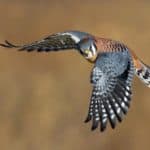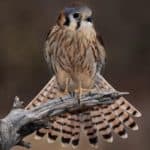Written by Alyssa Cahoon
The American Kestrel, or Falco sparverius, is a famous falcon in the Red River Valley. They are often seen perched on telephone poles or high posts along roadsides and open country areas, making the prairie a favorite ecosystem by the species. You may spot one around the Red River in the Fargo and Moorhead area, but you’re much more likely to hear them first. American Kestrels have a signature call which can often be easily heard, making a “kleklekle” noise. Linked below is the American Kestrels’ signature call: https://www.audubon.org/sites/default/files/AMEKES_1.klee-klee-kleealarmcall_KYle.mp3?uuid=5e33863e5d6d3


If you do get a glimpse of an American Kestrel near the Red River, there are a few things to know to help you identify them. American Kestrels are one of the smallest species of falcon known today. They typically reach a length of approximately 12 inches with a wingspan of 24 inches. Male and female kestrels have different colored feathers and patterns. The females have more rust and brown colored feathers, mimicking their nests or areas they may perch for camouflage. Male kestrels have blue and grey feathers on their heads and tails. American Kestrels are also known for feathers making a black stripe pattern under their eyes. Local birders have shared with us it is common to see them arrive in March and leave in October.
Species such as American Kestrels are important to our Red River Valley area because they can help keep a balance of animals within our ecosystem and benefit us all. American Kestrels are identified as a raptor due to how they use their talons to capture their prey. They will fly above their prey and dive quickly downward, swooping to catch it. Their prey consists of large insects, small mammals, and small birds. Large grasshoppers, beetles, mice, and even quail can be prey to an American Kestrel.
American Kestrels are not currently listed as a concern on endangered animal identification lists and their populations appears stable in most areas of North America. However, in certain areas populations are beginning to decline due to habitat loss, competition from invasive species, pollution, and other unknown factors. We can help by creating nesting areas, bird boxes, and other sought-after resources in our backyards, open fields, and along the Red River Valley Area.
References:
https://www.audubon.org/field-guide/bird/american-kestrel
https://www.allaboutbirds.org/guide/American_Kestrel/id
https://peregrinefund.org/explore-raptors-species/falcons/american-kestrel
